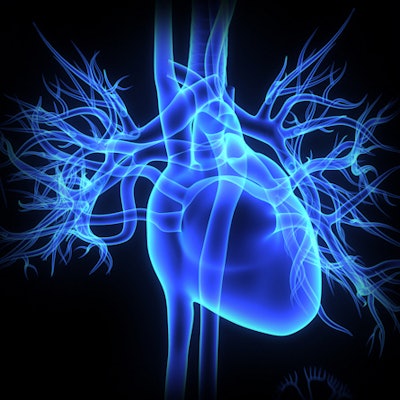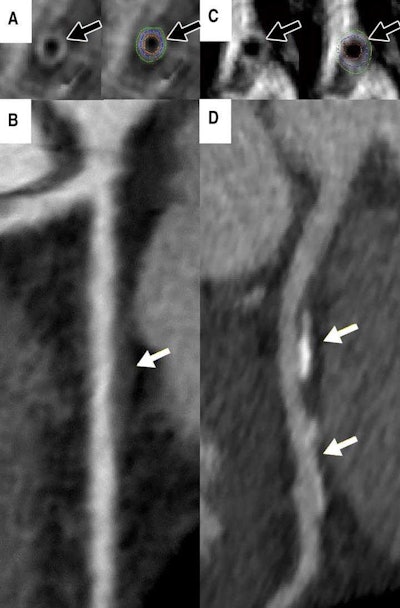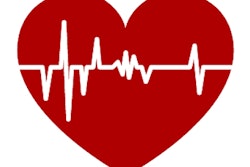
The thickness of the coronary wall is a marker for coronary artery disease (CAD) in women, and it can be visualized using MRI -- giving clinicians a potential tool to recognize heart disease in women earlier, according to a study published online April 25 in Radiology: Cardiothoracic Imaging.
The fact that MRI can be used to identify this marker for CAD offers patients and clinicians an alternative to traditional risk assessment frameworks -- which can be less effective in women -- as well as to more invasive imaging such as coronary CT angiography (CCTA), wrote a team led by Ahmed Ghanem, PhD, of the U.S. National Institutes of Health (NIH) in Bethesda, MD.
"Women tend to have less obstructive CAD, and the traditional risk scores (e.g., Framingham score) do not accurately reflect the extent of CAD in women," the group explained. "Traditional scoring systems used to predict patient risk for cardiovascular events are heavily weighted by age and sex, and as a result, CAD has been underestimated in asymptomatic women. This is reflected in the mortality rate from cardiovascular events, which has minimally increased or stagnated for women younger than 55 years compared with the decreases observed in the rest of the general population."
Closing the gap
Compared with men, CAD presents differently in women, often manifesting as myocardial infarction with nonobstructive coronary arteries, the researchers wrote. And tactics for assessing cardiovascular disease risk in women have had their limitations. A commonly used tool, the Framingham risk score, estimates risk based on age, sex, and other factors but underestimates heart attack risk in asymptomatic women. Meanwhile, imaging techniques like CCTA aren't recommended for risk assessment in a general population with no symptoms but are intended for patients with more advanced disease, they said.
That's why cardiac MRI shows promise as an alternative tool for early detection of CAD. It can visualize thickening in the artery walls, which tends to occur earlier in the course of the disease than stenosis, the narrowing of the arteries. And it doesn't require radiation or contrast.
"Despite the significant advances in CCTA technology, it is not appropriate to send all asymptomatic people to CCTA because of the exposure to radiation and chemical dyes used for imaging," said senior author Khaled Abd-Elmoniem in a statement released by the journal. "MRI might be a safe alternative that can be used more broadly to assist in the diagnosis of coronary artery disease without exposing patients to a procedure that carries some risk."
Over a number of years, the researchers developed an MRI technique that corrects for breathing and beating heart motion to visualize coronary wall thickness. Using this technique, they assessed the association between vessel wall thickness (VWT) and early CAD in 124 adults (62 women and 62 men, average age 45) with low or intermediate Framingham scores. All patients underwent CCTA to score their disease, then 3-tesla MRI to measure coronary wall thickness. The group also tracked the following CAD measures:
- Segment involvement score (SIS)
- Segment stenosis score (SSS)
- Segment volume score (SVS)
The team found that in young women -- beyond the CAD risk score and traditional risk factors such as age -- VWT of 1.41 mm or higher indicated substantial CAD.
"In women, vessel wall thickness was the only statistically significant independent variable associated with SIS and SVS at both univariable and multivariable regression analyses," the group wrote. "The VWT cutoff that was associated with a greater than 50% likelihood of SIS greater than 5 and an SSS greater than 5 was 1.41 mm."
 A: Cardiac MRI in a 46-year-old asymptomatic woman shows measured vessel wall thickness of 1.3 mm (black arrows). B: CT angiography shows noncalcified plaque (white arrow) in the proximal left anterior descending coronary artery. C: Cardiac MRI in a 44-year-old asymptomatic woman shows thicker coronary vessel wall (black arrows). D: CT angiography shows coronary artery disease (white arrows). Courtesy of the Radiological Society of North America.
A: Cardiac MRI in a 46-year-old asymptomatic woman shows measured vessel wall thickness of 1.3 mm (black arrows). B: CT angiography shows noncalcified plaque (white arrow) in the proximal left anterior descending coronary artery. C: Cardiac MRI in a 44-year-old asymptomatic woman shows thicker coronary vessel wall (black arrows). D: CT angiography shows coronary artery disease (white arrows). Courtesy of the Radiological Society of North America.The fact that MRI of vessel wall thickness proved to be a strong independent factor of heart disease in young women is a promising study finding that could positively influence patient care, the team noted.
"The low prevalence of stenotic CAD by using angiography or coronary CT angiography highlights the distinctive nature of coronary atherosclerosis in women and the limitation of luminography-based methods for identifying VWT as a surrogate for subclinical atherosclerosis," the group wrote. "Our data are a step forward in identifying a noninvasive MRI technique as a potential modifier for use in CAD assessment, particularly in young women."
Informed decisions
Not only could this MRI technique help clinicians better understand CAD in general, and specifically how it manifests in women, but also it could help them make more informed treatment decisions, corresponding author Dr. Ahmed Gharib told AuntMinnie.com.
"This technique has the potential to help clinicians monitor therapy noninvasively," he said. "CAD treatment doesn't always mean medicine -- it can be changing one's eating or exercise habits as well. We could use MRI to assess what works for particular patients. The fact that it catches CAD early, before the coronary vessels have had a chance to narrow, could translate into more time to find the best way to treat CAD in the individual patient."



.fFmgij6Hin.png?auto=compress%2Cformat&fit=crop&h=100&q=70&w=100)





.fFmgij6Hin.png?auto=compress%2Cformat&fit=crop&h=167&q=70&w=250)











